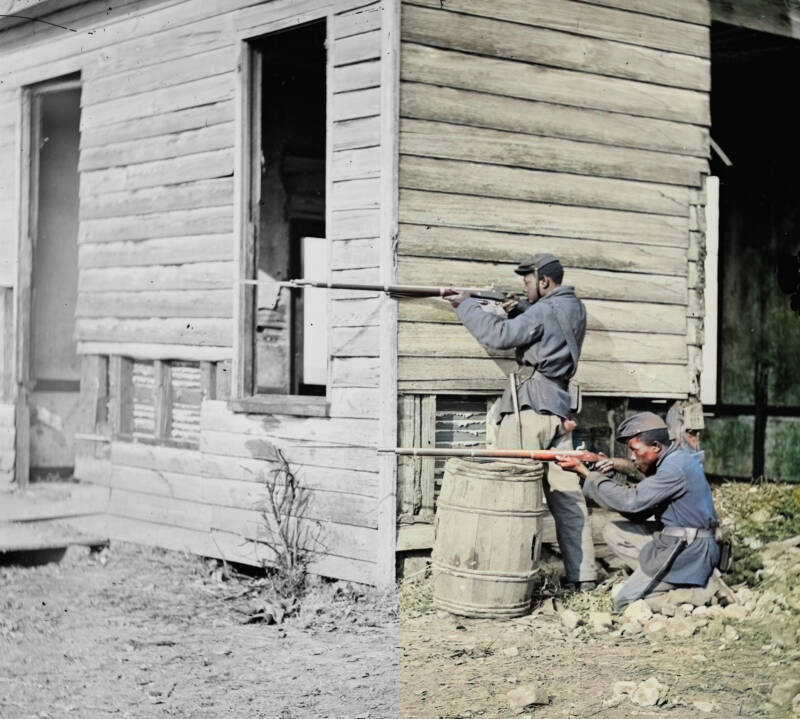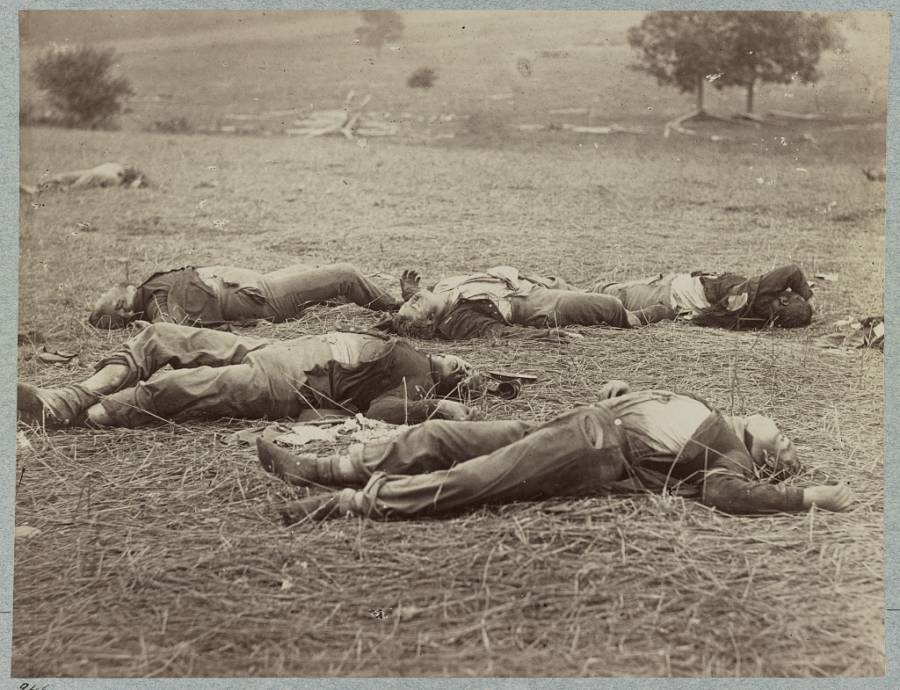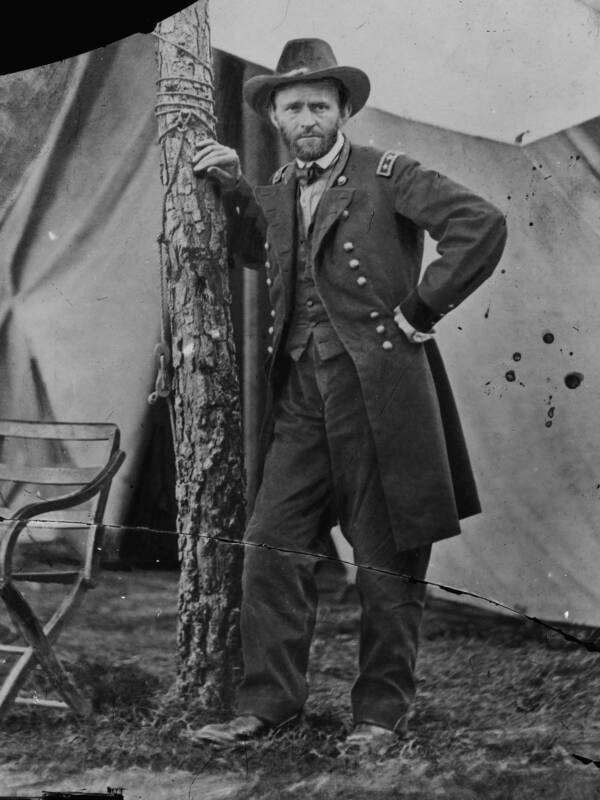Civil War Soldiers North and South Coloring Clip Art
Colorized Civil War Photos That Bring America'southward Deadliest Disharmonize To Life
With more than than one-half a million expressionless in just four years, the Civil State of war was America'due south bloodiest conflict and the starting time-always to be extensively documented through photography.
President Abraham Lincoln stands on the battlefield at Antietam, Maryland with Allan Pinkerton (the famed armed services intelligence operative who essentially invented the Underground Service, left) and Major General John A. McClernand (right) on Oct. iii, 1862. Alexander Gardner/Library of Congress
African-American Spousal relationship soldiers at Dutch Gap, Virginia in November 1864. Costless black men and former slaves joined the Marriage Army ranks as the state of war progressed and the Union lifted restrictions barring the raising of "colored" regiments due to the need for more men who were willing to fight. In total, more 180,000 black men served in the U.South. Ground forces, with another xx,000-plus black sailors serving in the U.S. Navy. Library of Congress
Almost xx minutes after the 6th Maine Infantry Regiment, known as the "Screaming Demons," hurdled over this section of wall in Fredericksburg, Virginia, on May three, 1863, Andrew J. Russell photographed the Confederate soldiers who had died trying to agree it. In the sunken ditch between the road and the wall, several dead Amalgamated soldiers can exist seen laying where they cruel. U.S. National Archives
The crew of the USS Monitor, one of the very first "ironclads" — steam-powered ships made with an fe hull — cook food on deck on July 9, 1862. U.S. Naval History And Heritage Command
Corporal Francis E. Brownell, of the 11th New York Infantry "Fire Zouave" Regiment, in the Zouave uniform inspired by the elite French units of the same name. Brownell won the first Civil State of war Medal of Honor when he shot and killed a Confederate-sympathizing tavern possessor who had simply shot and killed Colonel E.E. Ellsworth, the leader of the Fire Zouaves, during the First Battle of Bull Run. Brady-Handy Photograph Collection/Library of Congress
African-Americans collecting the bones of soldiers killed during the Boxing of Cold Harbor, near Mechanicsville, Virginia, in the leap of 1864. John Reekie/Library of Congress
Three Confederate prisoners of state of war, captured at Gettysburg, Pennsylvania, in the summer of 1863. Library of Congress
Amalgamated expressionless lay fallen following the Battle of Antietam, which began in Sharpsburg, Maryland on Sept. 17, 1862. This especially encarmine clash produced more than fifteen,000 casualties in the showtime eight hours of fighting alone. A farm lane cutting through the battlefield, seen here, was called "Bloody Lane" considering of the 5,000 who died there. Alexander Gardner/Library of Congress
Partially titled "A Harvest of Death," this Battle at Gettysburg photo from July 1863 shows but virtually a dozen of the approximately 7,000 men who died during the most of import boxing of the entire war. After the forces of Amalgamated Gen. Robert Eastward. Lee clashed with those of Spousal relationship Gen. George Meade in this southern Pennsylvania boondocks, the South's north accelerate was forever halted and the war had reached its turning bespeak. Timothy H. O'Sullivan/Library of Congress
Lewis Powell, 21, in a cell onboard a U.Southward. Navy ship in Washington, D.C. afterward his abort on Apr 17, 1865 for the attempted murder of Secretarial assistant of State William H. Seward. In a coordinated conspiracy to assassinate Pres. Abraham Lincoln, Vice-Pres. Andrew Johnson, and Sec. Seward, only Lincoln's assassination — at the hands of co-conspirator John Wilkes Berth — was successful.
Lewis Powell, 21, onboard a ship in the Potomac river after his arrest on April 17, 1865. Powell, along with three other co-conspirators, was convicted and hanged on July vii, 1865. Alexander Gardner/Library of Congress
The 96th Pennsylvania Volunteer Infantry Regiment in germination at Army camp Northumberland, Virginia in 1862. The 96th would run across action at the Battles of Antietam, Fredericksburg, Chancellorsville, and Gettysburg. Cyberspace Archive Book Images/Flickr
U.Southward. Ground forces Gen. William Tecumseh Sherman in 1864, sitting on his equus caballus at Federal Fort No. vii in Atlanta, Georgia during his "March to the Sea" entrada of scorched-earth warfare across the Confederate states. George N. Barnard/U.S. Library of Congress/Getty Images
Wedlock officers and enlisted men stand around a 13-inch mortar, the "Dictator," on the platform of a flatbed railroad car in October 1864 near Petersburg, Virginia. David Knox/Library of Congress/Getty Images
A sketch of the H.50. Hunley, a Confederate submarine that became the first submarine to sink an enemy warship in combat. In February 1864, the H.L. Hunley defeated the USS Housatonic, sinking it in less than five minutes and taking the lives of five sailors on board. However, the H.L. Hunley never made it back to port and the vessel was lost for more than 100 years before being discovered in 1970. Getty Images
On June 18, 1864, a cannon took both of Alfred Stratton's arms. He was just xix years old. He died x years later at the historic period of 29, after having fathered ii children. Mütter Museum
Bodies of Amalgamated artillerymen near Sharpsburg, Maryland subsequently the Battle of Antietam on Sept. 17, 1862 — the single deadliest 24-hour interval in U.South. military machine history. National Parks Service
Considered i of the near hard-nosed generals in U.South. military history, William Tecumseh Sherman wasn't immune to the ravages of the disharmonize. In one wartime alphabetic character, he wrote: "I confess, without shame, I am sick and tired of fighting... tis but those who accept never heard a shot, never heard the shriek and groans of the wounded and lacerated ... that weep aloud for more blood, more than vengeance, more than desolation." Wikimedia Commons
Confederate Gen. Robert E. Lee, a Westward Bespeak graduate, was initially asked past newly-inaugurated President Abraham Lincoln to take command of the U.Southward. Regular army and put downward the insurrection of the breakaway southern states of the Confederacy, including his native Virginia. Instead, he joined the Confederacy and became its most prominent general. Wikimedia Eatables
The ruined remains of a Charleston, S Carolina railroad depot in 1865, destroyed during Gen. Sherman's campaign in the Carolinas. The previous year, Sherman sent a letter to the mayor and metropolis quango of Atlanta, Georgia, warning the Confederate holdouts: "Now that war comes abode to yous, you experience very unlike... I want peace, and believe information technology can only exist reached through matrimony and state of war, and I will always acquit war with a view to perfect and early success." Library of Congress
Titled "A Sharpshooter'due south Concluding Sleep, Gettysburg, Pennsylvania," this photo and other Ceremonious War photos like it present armed conflict in a grim, unsanitized way that markedly contrasts earlier centuries' artistic depictions of the glories of war. Alexander Gardner/National Gallery Of Art
Confederate General Thomas "Stonewall" Jackson, an early Amalgamated hero and loyal lieutenant of Gen. Robert East. Lee, was killed after existence hit by friendly fire during the Battle of Chancellorsville on May ii, 1863, necessitating the amputation of his arm. His body weakened, Jackson died viii days later on of pneumonia. Wikimedia Commons
Union artillery at Yorktown, Virginia, circa 1862. James F. Gibson/Library of Congress
Union soldiers in a trench before the Battle of Petersburg, 1864. Getty Images
U.S. Army Gen. William Tecumseh Sherman, circa 1864-65. It would take the Southern states decades to recover from Sherman'south "March to the Sea" campaign of scorched-earth warfare. Wikimedia Commons
Abraham Lincoln in 1861, at the dawn of the Civil War. Mads Dahl Madsen/Dynamichrome/Daily Mail
A Confederate soldier lays dead on the battlefield. Smithsonian
General George Custer, who later became famous at Petty Big Horn. Mads Dahl Madsen/Dynamichrome/Daily Mail
Confederate Generals Robert East. Lee, Thousand.W.C Lee, and Walter Taylor. Twisted Sifter
The Navy hired immature teenagers, like this one – dubbed "powder monkeys" – to run gunpowder from the munitions room to the cannons. Said "monkeys" were as young as 12 years former. Imgur

Colorized Civil War Photos That Bring America's Deadliest Conflict To Life
The growth of photography in the middle of the 19th century kicked off, among many other things, a revolution in the recording of history. Momentous events and public figures could now be documented in existent time in a way that hadn't been possible before unless you lot were really at that place to deport witness.
Yet this revolution can sometimes be difficult to appreciate today, with old photos in sepia tones that look alien in our vibrantly-colored mod world. This is precisely what makes colorized photos of a period such every bit the Ceremonious State of war both revelatory and important historical documents.
More than than just artistic reproductions, such colorizations restore the immediacy of the bodily historical events in question.

Library of Congress African-American Spousal relationship soldiers at Dutch Gap, Virginia in Nov 1864.
Before photography, people were used to seeing drawings or paintings of an event, pulled from the fallible memories of an artist or from the secondhand accounts of witnesses long after the fact. For most of human being history, this was all the public could access -- if they were lucky.
But photography brought the immediacy and stark truths of important events to the masses for the get-go time — no matter that it was black and white for audiences who had never seen a photograph of any kind before.
And today — with color cameras on the phones we all carry around in our pockets — pictures of, say, Union Gen. William Tecumseh Sherman in varying shades of gray tin feel like distant artifacts from another globe. Even so, a colorized photograph of the Ceremonious State of war general reminds us that he was once very much a flesh-and-claret person, one who was critically of import to one of American history's defining chapters.
How The Ceremonious War Turned Photography From A Novelty Into A Mass Medium

Mütter Museum On June 18, 1864, a cannon shot took both of Alfred Stratton's arms. He was just 19 years quondam.
Invented in 1824 past Nicéphore Niépce, heliography was the first-ever procedure invented to preserve an epitome from the lite striking a argent plate, bringing the world the very first documents akin to what we know equally photographs. The exposure procedure however took several days, however, then its utility in documenting events was most nonexistent.
A few years later, Niépce began working with Louis Daguerre -- of daguerreotype fame -- who would continue to pioneer the process of photography after Niépce's death in the early 1830s. Past the outbreak of the American Civil State of war some three decades later, pictures of people and events still weren't widespread, but that was all almost to change.
Cheers to the advances in camera and photo processing technology, exposure times required for pictures were vastly reduced to a few seconds in most cases -- or even less. New chemical processes for the capture, treatment, and development of a photographic prototype were far more cumbersome and fragile than those in place today, but they were refined enough for trained professionals to have cameras into the globe and produce the first real documentary photographs anyone had ever seen.
As a result, the American Ceremonious War became the starting time armed conflict to exist extensively documented through photography (with the Crimean State of war the only possible precursor). Intrepid photographers like Alexander Gardner and Mathew Brady took cameras onto the battlefields of the Civil War and captured its grim realities, stripping the disharmonize of the romance effectually state of war commonly found in earlier periods.
The photographers who braved the Ceremonious State of war battlefields blazed the trail for the next century and a half of photojournalists. Furthermore, they ensured photography'southward position as an indispensable mass medium able to transmit its message to the illiterate every bit easily as to the most well-read.
Chronicling The Slaughter Of The Ceremonious War

Library of Congress Bodies of expressionless Union soldiers prevarication on the battlefield following the kickoff day of the Boxing of Gettysburg. 1863.
More than important than how photographers documented the period, even so, is what they were actually documenting. The American Civil War was the world's first industrialized conflict fought with what nosotros tin consider modern weaponry in the grand scope of history.
Rifled muskets -- which were far more accurate than previous generations of firearms -- and modern artillery could cut down entire lines of men in boxing, forcing lower-ranking officers and infantry commanders to abandon the quondam Napoleonic Era doctrine of an orderly line of soldiers firing volleys at the enemy over an open up field earlier launching into a bayonet accuse. Instead, small units of soldiers sought embrace and fired from behind walls and makeshift barricades, decimating enemy advances at longer range, and later fifty-fifty excavation trenches into the ground in which to seek refuge.
With these new ways to impale in place, the official number of Americans dead as a result of the war, both battlefield deaths and those who died of their wounds afterward, long stood at about 618,000. However, a recent reassessment using census data in 2011 put the full number of deaths as loftier as 850,000.

Library of Congress A Dead Confederate soldier at the Battle of Petersburg, in Petersburg, Virginia, 1865. The soldier had been shot in the head and died where he fell.
As much as iii pct of the total population of the U.s.a. was killed and the photos of the war delivered these horrors to the public in ways that merely weren't possible before the invention of photography.
After all, it was one affair to meet your son, father, or married man get off to war and never return; that has been one of the abiding sorrows of the human experience throughout history. It is some other thing entirely to encounter pictures of the bodies of dead men littering the battlefields of the state of war and wonder if your loved one is one of the broken figures contained therein.
Ceremonious State of war Photos Reveal The Horrors Of War To The Masses For The First Time

Wikimedia Commons Two portraits of President Abraham Lincoln; the left portrait from 1860, the year he won the presidency; the right portrait from 1865, the year he won the Ceremonious State of war, shortly earlier his assassination.
The men who led their governments and armies through the Civil State of war were photographed too, their portraits recording the toll the war had taken on them. President Abraham Lincoln, for instance, visibly anile in but iv brusk years, actualization more a decade older than he did on the eve of his ballot.
Gen. Ulysses Southward. Grant, whose campaign against Robert East. Lee'southward Army of Northern Virginia would eventually bring the war to an end, was captured in moments of exhausted candor during the entrada, stripped of some of the heroism that military machine commanders had long presented to the public.

Library of Congress U.S. Army Gen. Ulysses S. Grant standing in his camp at Cold Harbor, Virginia, in 1864. Grant would be derisively chosen "The Butcher" later the Marriage loss at Cold Harbor resulted in over 12,000 casualties.
Moreover, pictures of the Civil War captured death in ways that few who were removed from the actual battlefields had ever seen. In the 20th century, the ugliness of war hit dwelling in its fullest equally photography documented Globe State of war I's desolation of Europe, but the stripping away of war's mystique began with the Civil War.
As Gen. Sherman wrote to James Yeatman, a Missouri philanthropist, in May 1865: "It is only those who have never heard a shot, never heard the shriek and groans of the wounded and lacerated ... that cry aloud for more blood, more than vengeance, more pathos."
Civil War photography, for the first time, brought these grim realities to the public in means that would change history forever.
Subsequently viewing these colorized Civil War photos, dig into the causes of the Civil State of war, or bank check out these photos of the Boxing of Gettysburg, the clash that marked the beginning of the cease for the Confederacy.
Source: https://allthatsinteresting.com/color-civil-war-photos